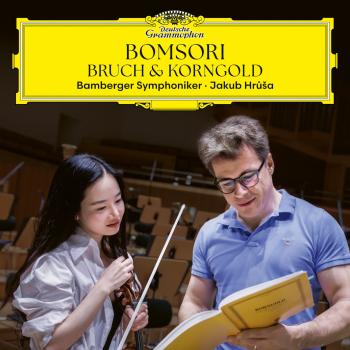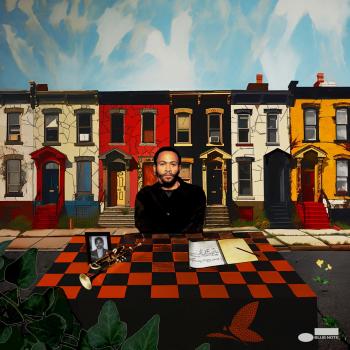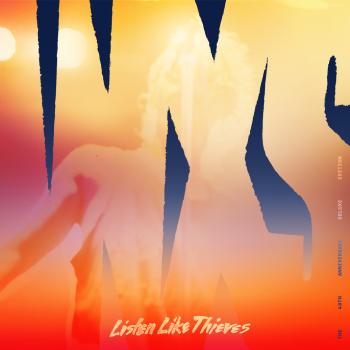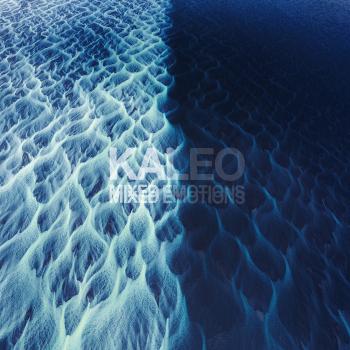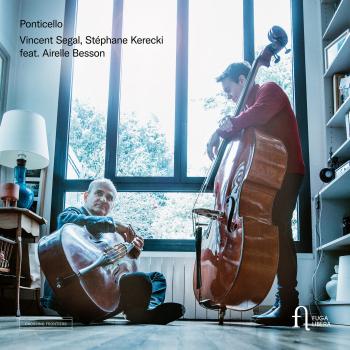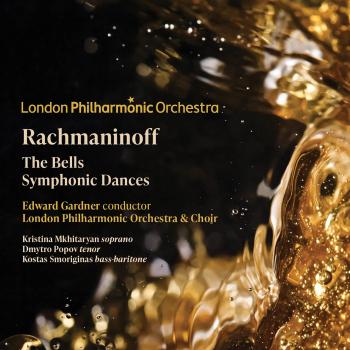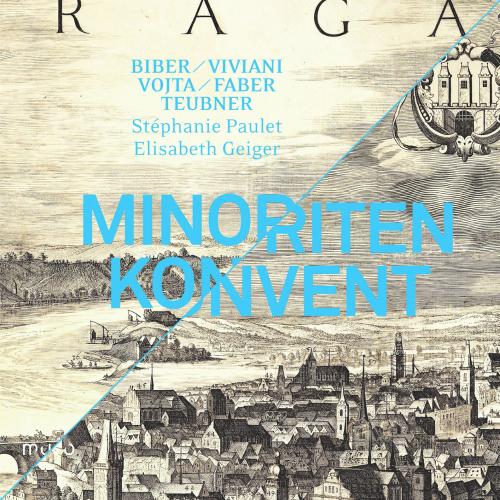
Minoritenkonvent Stephanie Paulet & Elisabeth Geiger
Album info
Album-Release:
2015
HRA-Release:
02.07.2021
Label: MUSO
Genre: Classical
Subgenre: Chamber Music
Artist: Stephanie Paulet & Elisabeth Geiger
Composer: Heinrich Ignaz Franz Biber, Giovanni Buonaventura Viviani, Jan Ignác František Vojta, Nikolaus Faber, Johann Caspar Teubner
Album including Album cover
- Heinrich Ignaz Franz Biber (1644 - 1704):
- 1 Biber: Sonata No. 84 n E Major / Sonata No. 77 in A Major 08:14
- Anonymous:
- 2 Anonymous: Sonata No. 87 in F Minor 06:58
- 3 Anonymous: Sonata No. 4 in D Major 05:32
- Giovanni Buonaventura Viviani (1638 - 1693):
- 4 Viviani: Sonata No. 90 in A Minor 08:24
- Anonymous:
- 5 Anonymous: Sonata No. 75 in C Minor 09:10
- Jan Ignác František Vojta (1660 - 1725):
- 6 Vojta: Sonata No. 70 in B Minor 08:37
- Nikolaus Faber (1350 - 1422):
- 7 Faber: Sonata No. 2 in E Major 05:49
- Heinrich Ignaz Franz Biber:
- 8 Biber: Sonata No. 11 in E Minor 11:12
- Johann Caspar Teubner (1661 - 1697):
- 9 Teubner: Toccata No. 94 in A Minor / Sonata No. 88 in D Minor 08:31
Info for Minoritenkonvent
Although even now little studied by musicians, Manuscript XIV 726 of the Convent of the Minorites in Vienna has been known to musicologists for many years. It reveals flourishing violin activity in the period from the late seventeenth century to the North of the Alps, and the most celebrated representative was unquestionably Biber. In this crucial period, the school of instrument making evolved with the style of the sonatas, independently of what was taking place in Italy. The opposition – or complementarity – of the musicians of court and city gave rise to keen rivalry between them, on account of the regular ‘competitions’ for their positions. The sonatas performed here are thus highly advanced as regards violin technique of the time; the works are virtuosic, many passages are written as improvised preludes; the violin plays a succession of runs, diminutions… Everything is written, yet in the style of an improvisation.
Although the Manuscript includes a great number of them, only two sonatas on this disc are written in scordatura, a violin technique considered typically German and consisting of modifying the violin’s tuning – G D A E – and proposing new tuning for each of the sonatas. This can create an extravert character and reinforce a spirit of dance (Faber’s sonata), or create a darker, melancholic tone-colour, with a veiled, less resonant sound, as with Vojta.
As nothing was indicated for the instrumentation of the continuo, the organ seemed the ideal partner for exploring these sonatas: as the music is by turns meditative, illustrative or dancelike, it called for a continuo that was varied in regard to tone-colour and dynamics, capable of moving from the intimate to the majestic. And what is the organ in question? It is the only ‘positive’ (i.e. placed on the floor, unlike organs in lofts) of the organ builder André Silbermann that still exists, restored in 2011 to its original condition and possessing an exceptional sound.
After a first disc devoted to Guillemain, released in 2012, and already very highly praised by the press, Stéphanie Paulet has once more scored a hit with this Minoritenkonvent. Her lyrical violin is always spot on. This disc, the aural beauty of which makes us positively vibrate, is enhanced by sound engineering that is quite simply magnificent.
"The Manuscript XIV 726 of the Convent of the Minorites in Vienna has been known to musicologists for many years. It reveals flourishing violin activity from the late 17th century, to the North of the Alps, and its most celebrated representative was unquestionably Biber. In this crucial period, a school of instrument-making evolved with the local sonata style, independently of what was taking place in Italy. The opposition of the musicians of court and city gave rise to keen rivalry between them, on account of the regular competitions for their positions. The sonatas performed here are thus highly advanced as regards violin technique of the time; the works are virtuosic, many passages are written as improvised preludes. Everything is written down, yet in the style of an improvisation. Although the Manuscript includes a great number of them, only two sonatas on this disc are written in scordatura, a violin technique considered typically German and consisting of modifying the violin s tuning - G D A E - and proposing new tuning for each of the sonatas. This can create an extravert character and reinforce a spirit of dance (Faber s sonata), or create a darker, melancholic tone-colour, with a veiled, less resonant sound, as with Vojta. As nothing was indicated for the instrumentation it called for a continuo that was varied in regard to tone-colour and dynamics, capable of moving from the intimate to the majestic. The organ used is the only positive (i.e. placed on the floor, unlike organs in lofts) of the organ builder André Silbermann that still exists, restored in 2011 to its original condition and possessing an exceptional sound. After a first disc devoted to Guillemain, MU004, released in 2012, Stéphanie Paulet, first violin of Laurence Equilbey's Insula Orchestra scores a hit with this project that reveals the flourishing violin activity in the late 17th century to the North of the Alps. Accompanied by a positive organ of exceptional sound quality, her violin sings, leaps and makes us vibrate through the aural beauty of this disc, enhanced as it is by quite simply magnificent sound engineering."
Stephanie Paulet, violin
Elisabeth Geiger, organ
Aliquando
Created at the instigation of Stéphanie Paulet, (1st violin, musical direction, research), the ensemble Aliquando was born of the desire to bring back to life today the beauty of the music of the past. He has brought together artistes with solidly established reputations, each committed to an active, individual musical approach. Aliquando is thus the natural focal point of an ensemble of musicians wishing to explore, amongst other things, the immense variety of the French musical heritage of the eighteenth century.
A flexible formation of variable composition, it unites artistes with solidly established reputations, each committed to an active, individual musical approach.
Aliquando, turned towards research and the valorisation of music that has been too often neglected, does not exclude composers who have by now achieved recognition. It can cope as well with the reduced groupings suitable for chamber music as for more substantial formations.
Stephanie Paulet
First violin of the Insula Orchestra conducted by Laurence Equilbey, a group performing throughout France and abroad on historic instruments, Stéphanie PAULET regularly appears in recitals and in chamber music concerts alongside faithful partners. After three first prizes at the Paris Conservatory she travelled throughout Europe and Asia as a modern violinist with the piano trio Pantoum, and in orchestras conducted by Claudio Abbado and Bernard Haïtink. She then undertook a historical examination of the baroque and classical repertories. For ten years she was the first violin of many baroque ensembles in Paris including Il Seminario Musicale, Les Talens Lyriques, and the Concert d’Astrée.
In 2012 she founded the ensemble Aliquando in order to revive the beauty of earlier music and in particular of the baroque period, and also to champion on stage their ever lively and vivid character. A first disc, Amusements, devoted to Louis-Gabriel Guillemain, released by muso, was rewarded with a ‘Five’ from Diapason, a ‘Five’ from Muse Baroque, and was lauded by the BBC Music Magazine.
Preoccupied with precision of play as much as by musical research, she is also greatly interested in crossovers with other forms of expression and has written two shows for Aliquando: La leçon de musique ou la machine à couleurs in 2012, based on texts of Diderot and on music for solo violin, and Le poète et le chansonnier, a show premiered in March 2015 for the Maison de Chateaubriand alongside Daniel Isoir, pianofortist, and Arnaud Marzorati, singer and reciter.
The holder of a teaching certificate (CA) for the violin, she has found particular pleasure in seeking to transmit and teach the baroque violin at the Hochschule of Bremen in Germany since 2011, as well as at the conservatories of Saint-Maur and Versailles since 2014.
In 2014 she was appointed ‘Chevalier des Arts et des Lettres’.
This album contains no booklet.


